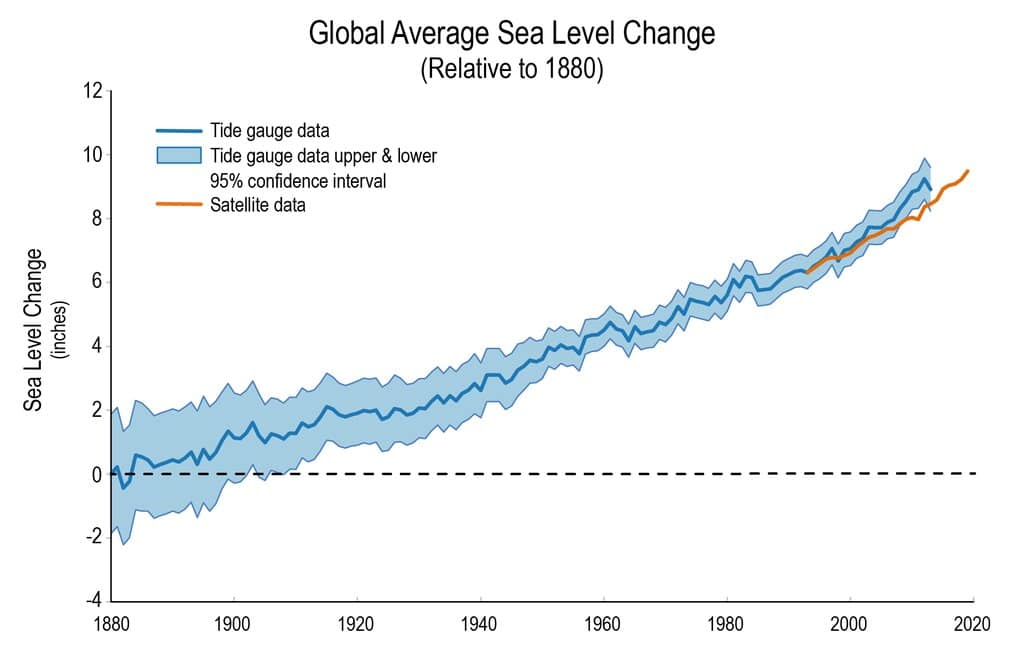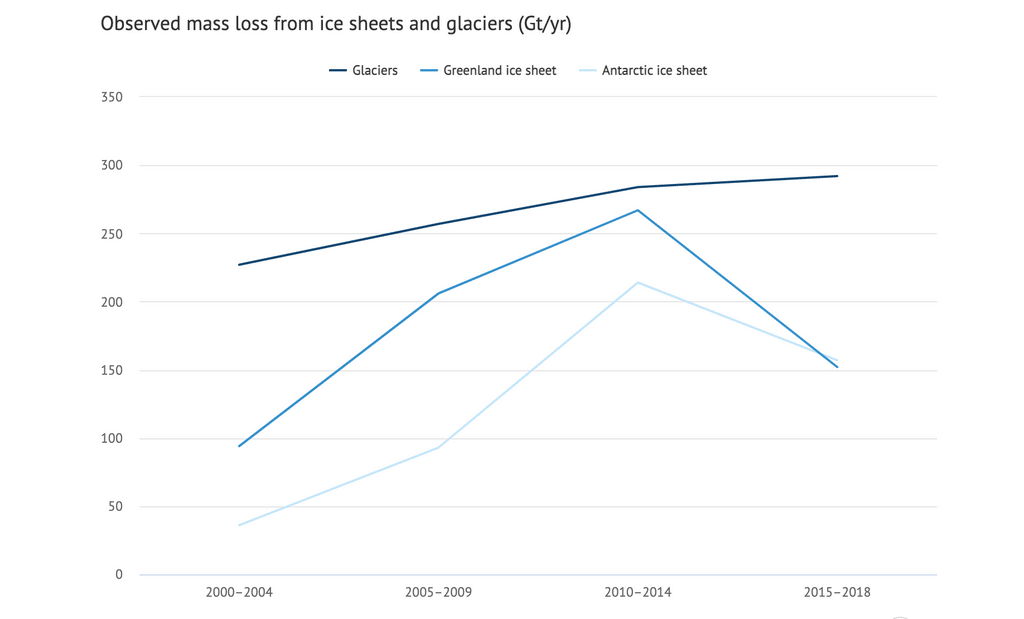Humans started measuring the level of seas more than 200 years ago and found this to be an important climate indicator of how rapidly global warming is accelerating. Today, sea levels are rising more than twice as quickly as they did for most of the 20th century as a result of increasing temperatures on Earth. This phenomenon has catastrophic consequences on coastal areas, destroying infrastructures and displacing millions of people every year. We take a look at what causes sea level rise and why it matters.
—
Sea level has risen by about 24 centimetres since 1880. Throughout most of the 20th century, it rose at a rate of 1.4 millimetres per year. However, between 2006 and 2015, the rate nearly doubled, reaching about 3.6 millimetres annually. According to the State of the Climate Report, in 2020, the sea was at its highest recorded level, with the global mean reaching 91.3 millimetres above the average in 1993, the year that marks the beginning of the satellite altimeter record. Not surprisingly, 2020 was also among the three warmest years the world has ever had with tropical cyclones occurring well above average at the same time.
Sea-level rise projections show that, even if the world follows a low greenhouse gas pathway, the level of seas globally will continue to rise up to about 0.7 metres by the end of this century. However, should the world fail to cut down emissions and reach the 3C or even 4C mark, sea levels could rise as much as 2.8 metres above 2000 levels by 2100.
Figure 1: Sea Level Rise, 1880-2020
The reason why sea level matters so much is that extreme events that are associated with this phenomenon – such as floodings, shoreline erosion, and hazards from storms – have devastating effects on urban settings along coastlines worldwide. These events threaten residential and commercial buildings, infrastructures such as roads, bridges, and subways as well as water supplies, power plants, and landfills. According to the United Nations, the potential costs associated with damage caused by sea level rise could reach USD$111.6 billion by 2050 and even a staggering USD$367.2 billion by the end of the current century.
Globally, eight of the world’s 10 largest cities – Tokyo, Mumbai, New York, Shanghai, Lagos, Los Angeles, Calcutta, and Buenos Aires – are located near a coast. At the same time, the rate of population growth in coastal areas is also accelerating. Currently, about 10% of the world’s population lives in coastal areas that are less than 10 metres above sea level, and approximately 44% is located within 100 kilometres of the coast, which makes them extremely vulnerable to sea level rise. The countries most at risk by sea level change are China – with nearly 43 million people living in precarious coastal locations, Bangladesh with 32 million, and India with 27 million people. Many urban conglomerates along the US coastline are also experiencing 300% to 900% more disruptive high-tide floods than 50 years ago. Among the most flood-prone islands are the Maldives – the Earth’s flattest country made up of 1,200 small islands and home to approximately 540,000 people – and Kiribati, a small island located in the heart of the Pacific with a population of 120,000.
What Is Causing Sea Level to Rise?
The Volume of the Ocean Expands as the Water Warms
Among the primary causes of rise in sea level is a phenomenon known as thermal expansion, which is prompted by higher ocean temperature. The Earth is getting warmer primarily due to the accumulation of heat-trapping greenhouse gases, 90% of which are absorbed by the oceans. As the water’s temperature rises, the volume of oceans expands.
This phenomenon has been occurring at a steady rate for decades and accounts for nearly 75% of the sea level rise that occurred over the course of the 20th century. However, as the shrinking of ice masses accelerates, its relative contribution, despite being still quite high, has partly declined. Between 1993 and 2010 the rapid increase in ocean heat content has led to approximately 19 millimetres of sea level rise, accounting for a third of the total increase of 54 millimetres over the same period.
Figure 2: Ocean Mass, 2002-Present
Glaciers and Ice Sheets are Melting
Around 10% of the world’s land surface is currently covered by glaciers, which stores 70% of the Earth’s freshwater. However, with global warming and rising temperatures, these massive ice bodies are retreating at unprecedented rates.
Between 1994 and 2017, glaciers worldwide lost nearly 30 trillion tons of ice and they are now melting at a rate equivalent to 1.2 trillion tons a year. Among the glaciers that are disappearing the fastest are those located in the Alps, Iceland, and Alaska. The latter alone accounted for 25% of the global mass loss. Similarly, the Antarctic ice sheet – the world’s largest single mass of ice – is melting at an unprecedented rate and it has the potential to contribute more than a metre of sea level rise by 2100 and more than 15 metres by 2500. Similarly, between 2012 and 2016, the Greenland ice sheet was losing 247 billion tons per year, disappearing at a rate that is more than seven times higher than throughout the 1990s.
As a cause of sea level rise, glacier loss was second only to thermal expansion. Between 2000 and 2019, meltwater from glacier and ice sheet loss alone accounted for 21% of the global sea level rise, research by Nature found.
Figure 3: Observed Mass Loss from Ice Sheets and Glaciers, 2000-2018
Liquid Water on Land is Declining and Shifting to Oceans
Human activities and climate change have an impact on the water cycle, which directly affects the amount of water not only in the oceans but also on land, such as in lakes, rivers, groundwaters, and reservoirs. Every year, about six tonnes of water cycles through the Earth’s land surface. Rain gets held up in the water bodies and soil on its journey back to the ocean, which is referred to as ‘land water storage’. Humans speed up this cycle by continuously extracting water from the ground and wetlands, which eventually ends up in the oceans.
Despite being a relatively minor contributor to sea level rise, land water storage is still an important part of the equation, with several studies showing how climate-driven increases in liquid water storage on land have affected changes in sea levels. Over the past two decades, extracted groundwater added 0.38 millimetres per year to global sea levels. Furthermore, scientists expect land water storage to contribute around 10% to the projected global mean sea level rise by the end of the 21st century. However, the percentage is considerably higher and can reach up to 60% in several high-risk regions including the Pacific islands, the south coast of Africa, and the west coast of Australia.
You might also like: Scientists Predict At Least One Foot of Sea Level Rise by 2050 in the US
Future Outlook
There is no doubt that the sea level will continue to rise in the coming decades. How much it increases will depend largely on the rate of future greenhouse gas emissions. We cannot predict when the tipping point might be reached and thus, our best and only option right now is to mitigate centuries of additional future sea level rise by taking drastic actions to reduce emissions in the future and avoid urban destruction and mass human displacement.








More Stories
Three Keys of Branding That Will Turn Small Business Advertising Expense into an Investment
Perbedaan Logo Design Dengan Branding
Travel Agents Can Help With Vacations and Business Travel